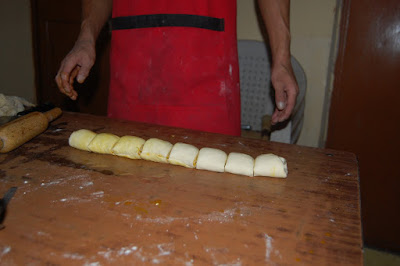Although it's been over three weeks since returning to the USA after my 3-month tour of SE Asia and India, there is one place in particular that is hard to shake from my memory.
Dana and I spent the last ten days of the trip relaxing in
Mcleodganj, a small town in the foothills of the Himalayas. We were surrounded by the Tibetan exile population. We were also surrounded by mist, rain, yoga studios, fresh yogurt, fruit, and vegetables, and a host of eccentric Western tourists.
Among the unique travelers was Brad from Australia, a long-haired, bearded, linen-pants-wearing New-Ager. He told me about his prophetic dreams and his thoughts on reincarnation as I attempted to finish Murakami's
Kafka on the Shore over cups of jasmine green tea and vegetable
momo soup at Om Cafe.
[Side note: Om Hotel and Cafe was one of my favorite places we stayed on the trip. The hotel was on the edge of an enormous hill, providing beautiful and unobstructed views of the valley. See below]
Anyway, Brad shared some nuggets of wisdom with us. Although he was preoccupied with his search for the Grail (which, according to him, extends into his multiple reincarnations and lifetimes), he managed to find some time to tell me about his prophetic dreams. Apparently a large earthquake will be striking the world, probably the West coast of the US, in the coming months. Now, I've heard (from scientific, reliable sources) that there is a pattern of major earthquakes hitting the Western US every few hundred years. So I guess it's not a completely improbable prediction. However, it's unlikely that it will happen so soon. I just thought I'd put it Brad's prediction out there. Don't say I didn't warn you.
All kidding aside, Mcleodganj was a perfect place for self-reflection. Nearing the end of our travels, it was nice to be in a calm place with cooler weather, high above the frantic chaos of Amritsar and the other Indian cities I had previously visited.
These pictures were taken on our first night in Mcleodganj. After arriving and eating a salad (my first vegetables after arriving in India), I watched the sunset on the balcony of Om Hotel while talking to one of the hotel's employees, a 32-year old former Tibetan monk.
Quite possibly the best part of traveling is meeting people with varied and unique lifestyles and histories. I would venture to say that my life experiences are almost diametrically opposed to those of Keso's, but it was powerful to talk to the exiled Tibetan and learn about his time in the monastery and his decision to leave his life as a monk. After visiting Tibet in 2008, I fell in love with the place andthe spirit of the people. Despite immense oppression and hardship, Tibetan culture is one of the the kindest and most peaceful on the planet.http://www.blogger.com/img/blank.gif
Here's to Tibet. May the Tibetan people soon be free of the injustice that leads to horrible events like this:
http://www.nytimes.com/2011/09/27/world/asia/two-tibetan-monks-set-themselves-on-fire-in-protest.html


















































